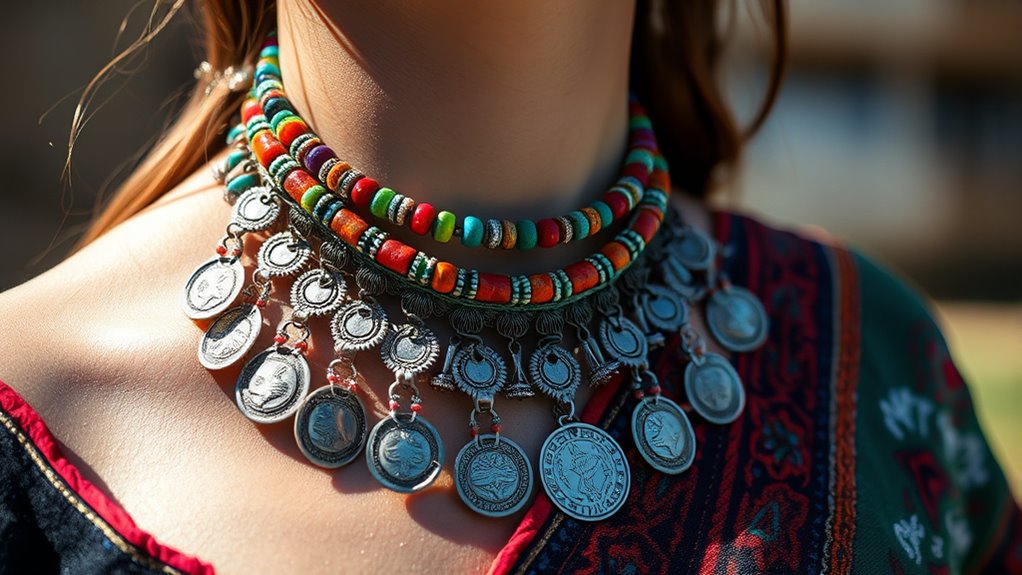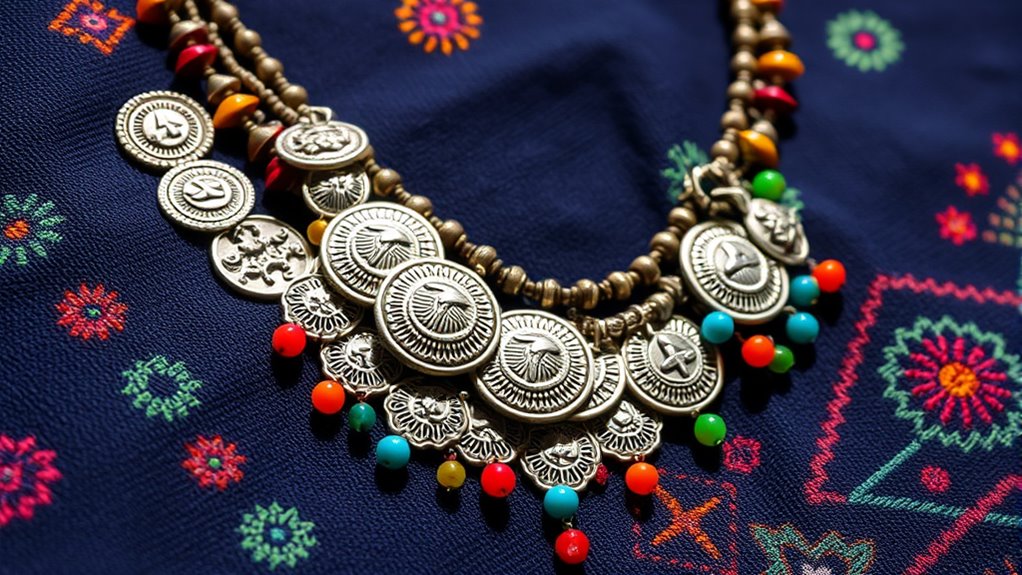Afghan Kuchi jewelry reflects the rich cultural heritage of nomadic communities, showcasing centuries-old craftsmanship and symbolic designs that represent social status, beliefs, and protection. With intricate techniques using silver, semi-precious stones, and colorful beads, these pieces serve as cultural markers and expressions of identity. Today, you can wear Kuchi jewelry to celebrate tradition, choosing statement pieces that honor their origins. To discover deeper stories behind its significance and how to style it meaningfully, there’s more to explore.
Key Takeaways
- Afghan Kuchi jewelry reflects centuries-old craftsmanship, symbolizing social status, tribal identity, and spiritual beliefs of nomadic communities.
- Crafted using traditional techniques like filigree and bead-stringing with silver, semi-precious stones, and colorful beads.
- Designs feature motifs inspired by nature and celestial symbols, believed to offer protection and spiritual connection.
- Jewelry serves as a communication tool, indicating social roles, tribal affiliations, and personal milestones within Kuchi nomads.
- Today, Kuchi jewelry is worn as vibrant statement pieces that honor cultural roots, support artisans, and celebrate artistic heritage.

Afghan Kuchi jewelry is a vibrant and intricate craft that reflects the rich cultural heritage of the Kuchi nomads. When you wear this jewelry, you’re not just accessorizing; you’re embracing a centuries-old tradition that carries deep cultural significance. Each piece is a testament to the traditional craftsmanship passed down through generations, showcasing skills that blend artistry with function. These artisans use age-old techniques to create jewelry that is both beautiful and meaningful, often incorporating symbolic designs that tell stories of their nomadic lifestyle, spiritual beliefs, and social status. The vibrant beads, silver accents, and ornate embellishments aren’t just decorative—they serve as cultural markers, connecting you to the history and identity of the Kuchi people.
Understanding the cultural significance behind Afghan Kuchi jewelry helps you appreciate its true value. For the Kuchi nomads, jewelry is more than adornment; it’s a form of communication. Certain designs and materials indicate marital status, social standing, or tribal affiliation. When you wear these pieces, you’re participating in a cultural dialogue that dates back hundreds of years. This jewelry often features motifs inspired by nature, such as flowers, animals, or celestial symbols, which reflect the Kuchi’s spiritual connection to their environment. In many cases, the jewelry is believed to hold protective qualities, warding off evil spirits or bringing good fortune. Wearing Kuchi jewelry, thus, becomes a way to honor those traditions and keep their stories alive. Additionally, the traditional craftsmanship involved in making Afghan Kuchi jewelry is highly detailed and labor-intensive. Artisans select materials carefully, often sourcing silver, semi-precious stones, and colorful beads from local markets or through trade routes. You might notice the meticulous handwork involved in each piece, from the intricate metalwork to the precise arrangement of beads. These techniques have been preserved over generations, with artisans executing complex processes like filigree, soldering, and bead-stringing. When you wear this jewelry, you’re showcasing more than style—you’re supporting a craft that sustains a community and preserves a cultural legacy. The craftsmanship isn’t merely functional but a form of artistic expression that embodies the resilience and creativity of the Kuchi nomads.
In modern times, people like you wear Afghan Kuchi jewelry to celebrate its beauty and cultural roots. Whether you choose a statement necklace, a pair of earrings, or a layered bracelet, incorporating these pieces into your wardrobe allows you to carry a piece of nomadic history. The key is to respect its origins by understanding what each design represents and wearing it with appreciation for its cultural significance. By doing so, you help keep this traditional craftsmanship alive and honor the stories woven into every bead and silver element. Afghan Kuchi jewelry isn’t just an accessory; it’s a vibrant symbol of a rich, enduring heritage.
Frequently Asked Questions
What Materials Are Traditionally Used in Afghan Kuchi Jewelry?
You’ll find that Afghan Kuchi jewelry traditionally uses a variety of materials, including metal alloys like silver and brass, which give it a vibrant shine. Bead weaving is also common, incorporating colorful glass or semi-precious stones. These materials combine to create bold, intricate pieces that reflect the region’s rich cultural heritage. The craftsmanship highlights skillful metalwork and detailed beadwork, making each piece uniquely stunning and culturally significant.
How Has Afghan Kuchi Jewelry Influenced Modern Fashion Trends?
You’ll notice Afghan Kuchi jewelry’s influence on modern fashion, especially in boho chic styles. It’s become popular as statement accessories, adding bold, vibrant touches to outfits. Designers draw inspiration from its intricate designs and rich history, making it a go-to for those seeking unique, culturally-inspired pieces. Wearing Kuchi jewelry today helps you stand out and express individuality, blending tradition with contemporary trends seamlessly.
Are There Specific Occasions to Wear Kuchi Jewelry?
You might think kuchi jewelry is only for special occasions, but it’s versatile enough for everyday adornment. While it’s perfect for cultural celebrations, don’t hesitate to wear it casually to add a unique touch to your daily outfits. Its bold designs make a statement, so whether you’re attending a festival or running errands, kuchi jewelry can elevate your look and showcase your appreciation for rich cultural heritage.
How Can I Identify Authentic Afghan Kuchi Pieces?
To identify authentic Afghan Kuchi jewelry, look for trademark markings that indicate genuine craftsmanship. Examine the craftsmanship details closely—handcrafted pieces often feature intricate metalwork, vibrant glass beads, and traditional designs. Authentic pieces may also show slight irregularities, reflecting artisanal skill. Be cautious of mass-produced imitations, and whenever possible, buy from reputable sources or trusted artisans to verify you’re getting genuine Afghan Kuchi jewelry.
What Is the Cultural Significance of Motifs Used in Kuchi Jewelry?
A picture is worth a thousand words, and in Kuchi jewelry, each symbolic motif tells a story. You’ll find tribal symbolism woven into intricate designs that honor tradition and identity. These motifs represent protection, fertility, and social status, making each piece a meaningful expression of cultural heritage. Wearing Kuchi jewelry allows you to connect with centuries of history, where every symbol holds significance and celebrates the rich tribal legacy.
Conclusion
Think of Afghan Kuchi jewelry as a treasure chest filled with stories and traditions, each piece a shimmering chapter of history. When you wear it, you’re not just accessorizing—you’re weaving yourself into a vibrant tapestry that stretches across generations. Like a storyteller passing down ancient legends, your jewelry connects you to a rich cultural legacy. Embrace it confidently, and let your style be a living, breathing part of this timeless, sparkling saga.










